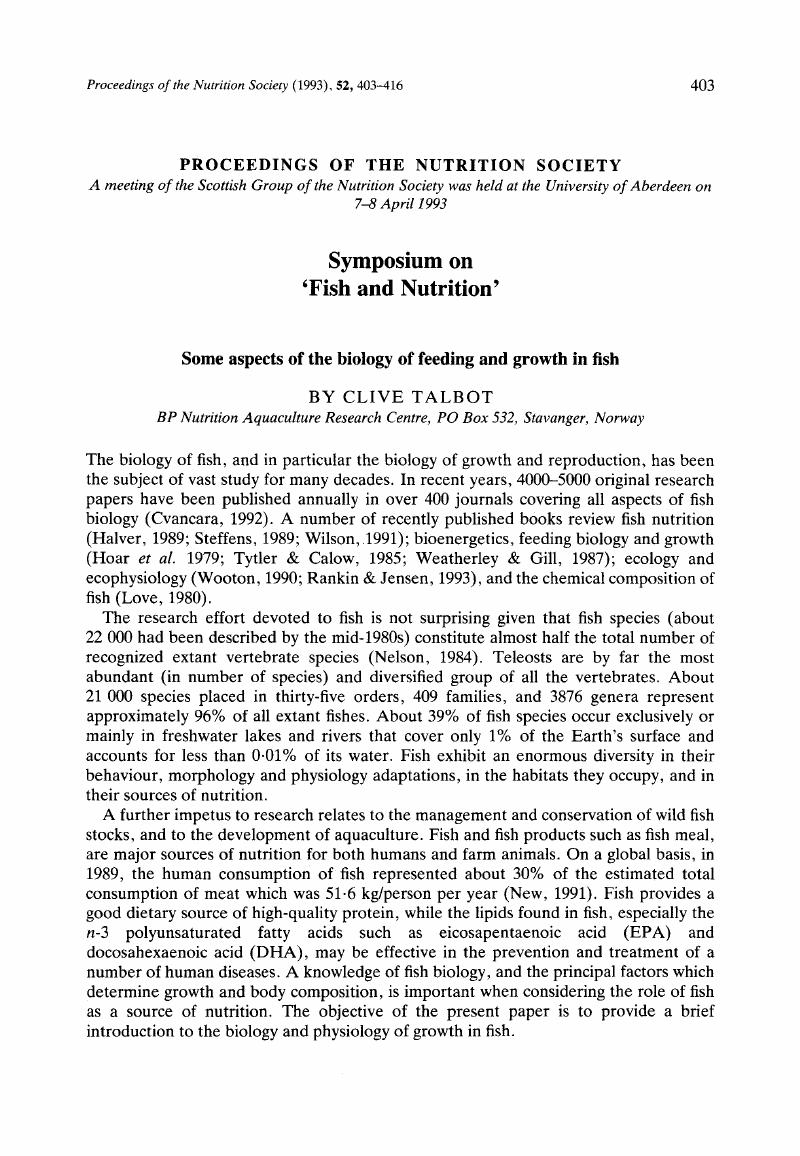Crossref Citations
This article has been cited by the following publications. This list is generated based on data provided by Crossref.
Einen, O
Holmefjord, I
Åsgård, T
and
Talbot, C
1995.
Auditing nutrient discharges from fish farms: theoretical and practical considerations.
Aquaculture Research,
Vol. 26,
Issue. 9,
p.
701.
Gélineau, A
Corraze, G
and
Boujard, T
1998.
Effects of restricted ration, time-restricted access and reward level on voluntary food intake, growth and growth heterogeneity of rainbow trout (Oncorhynchus mykiss) fed on demand with self-feeders.
Aquaculture,
Vol. 167,
Issue. 3-4,
p.
247.
Van Weerd, J.H
and
Komen, J
1998.
The effects of chronic stress on growth in fish: a critical appraisal.
Comparative Biochemistry and Physiology Part A: Molecular & Integrative Physiology,
Vol. 120,
Issue. 1,
p.
107.
Einen, Olai
Mørkøre, Turid
Rørå, Anna Maria Bencze
and
Thomassen, Magny Skinlo
1999.
Feed ration prior to slaughter—a potential tool for managing product quality of Atlantic salmon (Salmo salar).
Aquaculture,
Vol. 178,
Issue. 1-2,
p.
149.
Boujard, T
2000.
Effet du passé nutritionnel et du jeûne sur l'ingestion et la croissance de la truite arc-en-ciel Oncorhynchus mykiss..
Aquatic Living Resources,
Vol. 13,
Issue. 3,
p.
129.
Buentello, J.Alejandro
Gatlin, Delbert M
and
Neill, William H
2000.
Effects of water temperature and dissolved oxygen on daily feed consumption, feed utilization and growth of channel catfish (Ictalurus punctatus).
Aquaculture,
Vol. 182,
Issue. 3-4,
p.
339.
Gerhard, Glenn S.
2001.
Caloric Restriction in Nonmammalian Models.
Journal of Anti-Aging Medicine,
Vol. 4,
Issue. 3,
p.
205.
Middleton, T.F
Ferket, P.R
Boyd, L.C
Daniels, H.V
and
Gallagher, M.L
2001.
An evaluation of co-extruded poultry silage and culled jewel sweet potatoes as a feed ingredient for hybrid Tilapia (Oreochromis niloticus×O. mossambicus).
Aquaculture,
Vol. 198,
Issue. 3-4,
p.
269.
Yamamoto, T
Shima, T
Furuita, H
and
Suzuki, N
2002.
Influence of dietary fat level and whole-body adiposity on voluntary energy intake by juvenile rainbow trout Oncorhynchus mykiss
(Walbaum) under self-feeding conditions.
Aquaculture Research,
Vol. 33,
Issue. 9,
p.
715.
Bureau, Dominique P
Hua, Katheline
and
Cho, C Young
2006.
Effect of feeding level on growth and nutrient deposition in rainbow trout (Oncorhynchus mykiss Walbaum) growing from 150 to 600 g.
Aquaculture Research,
Vol. 37,
Issue. 11,
p.
1090.
VELÁZQUEZ, M.
ZAMORA, S.
and
MARTÍNEZ, F.J.
2006.
Effect of different feeding strategies on gilthead sea bream (Sparus aurata) demand-feeding behaviour and nutritional utilization of the diet.
Aquaculture Nutrition,
Vol. 12,
Issue. 6,
p.
403.
FU, S.J.
CAO, Z.D.
and
PENG, J.L.
2007.
Effect of purified macronutrients on specific dynamic action in carnivorous southern catfish.
Aquaculture Nutrition,
Vol. 13,
Issue. 3,
p.
216.
Wang, Yan
Kong, Ling-Jun
Li, Kai
and
Bureau, Dominique P.
2007.
Effects of feeding frequency and ration level on growth, feed utilization and nitrogen waste output of cuneate drum (Nibea miichthioides) reared in net pens.
Aquaculture,
Vol. 271,
Issue. 1-4,
p.
350.
2008.
Animal welfare aspects of husbandry systems for farmed European seabass and gilthead seabream - Scientific Opinion of the Panel.
EFSA Journal,
Vol. 6,
Issue. 11,
p.
844.
Bureau, Dominique
Hua, Katheline
and
Azevedo, Paula
2008.
Feeding and Digestive Functions in Fishes.
p.
547.
Szczepkowski, Mirosław
2009.
Impact of selected abiotic and biotic factors on the results of rearing juvenile stages of northern pike Esox lucius L. in recirculating systems.
Archives of Polish Fisheries,
Vol. 17,
Issue. 3,
Taylor, J.R.
Cooper, C.A.
and
Mommsen, T.P.
2010.
The multifunctional gut of fish.
Vol. 30,
Issue. ,
p.
213.
Cleveland, Beth M.
and
Burr, Gary S.
2011.
Proteolytic response to feeding level in rainbow trout (Oncorhynchus mykiss).
Aquaculture,
Vol. 319,
Issue. 1-2,
p.
194.
GÜLTEPE, N.
SALNUR, S.
HOŞSU, B.
and
HISAR, O.
2011.
Dietary supplementation with Mannanoligosaccharides (MOS) from Bio-Mos enhances growth parameters and digestive capacity of gilthead sea bream (Sparus aurata).
Aquaculture Nutrition,
Vol. 17,
Issue. 5,
p.
482.
2011.
The Economics of Salmon Aquaculture.
p.
221.





